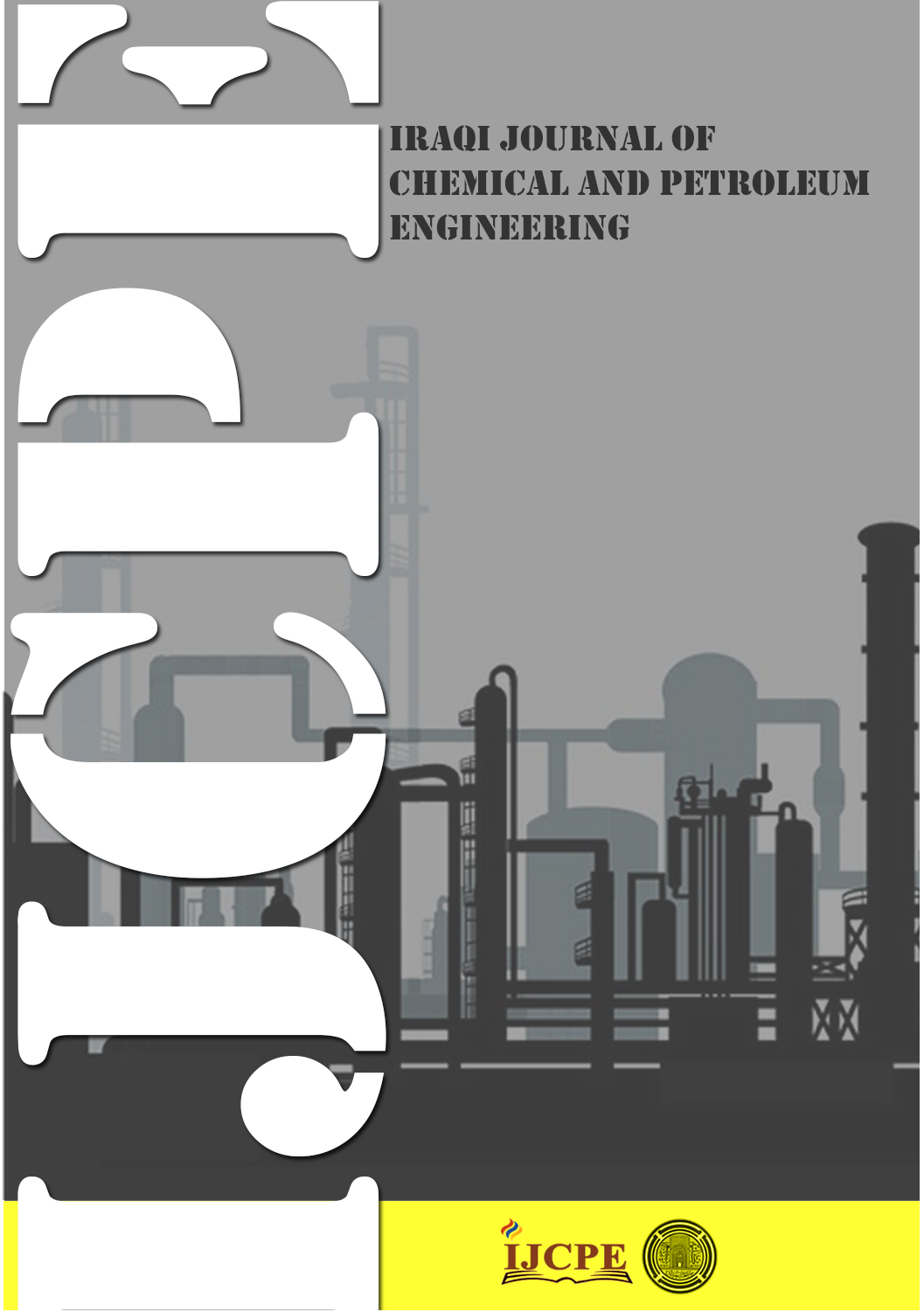Geological characterization and reservoir evaluation for Mishrif formation in Nasiriyah oilfield
DOI:
https://doi.org/10.31699/IJCPE.2025.2.10Keywords:
geological characterization; reservoir evaluation; Nasiriyah oilfield; hydrocarbon estimation; petrophysical modelingAbstract
Hydrocarbon estimation is a vital step for formation evaluation and development plans, significantly impacting the decision-making process. Well logs data from 40 wells in the Nasiriyah oilfield was utilised to characterise the Mishrif formation and construct a 3D static model. This model illustrates the spatial distribution of petrophysical properties and calculates the Original Oil in Place volume (OOIP) using a volumetric approach.
The model incorporates water saturation, effective porosity, permeability, and a 2D structural, which is discretized by 317130 grids. These petrophysical properties are populated in 3D dimensions using the geostatistical method SGS. At the same time, the difference in depths of OWC is captured and represented by three regions of initialization for accurate characterization of the reservoir. The geological modeling identified unit MB1 as the main reservoir in the Mishrif formation, characterized by an average porosity of 21.5%, permeability up to 500 md, and water saturation of 27%. However, unit MB2 exhibits similar petrophysical properties but with significantly higher water saturation above 70%, making it a water-bearing zone. The total OOIP volume for the studied reservoir was calculated to be 8535 MMSTB, mainly accumulated in units MB1 and MB2. Unit MB1 holds approximately 73% of the total oil in place, establishing it as the major reservoir in the Mishrif formation, while unit MB2 contains the remaining 27%.
Received on 06/09/2024
Received in Revised Form on 06/12/2024
Accepted on 06/12/2024
Published on 30/06/2025
References
[1] F. A. Al-Musawi, R. M. Idan, and A. L. M. Salih, “Reservoir characterization, Facies distribution, and sequence stratigraphy of Mishrif Formation in a selected oilfield, South of Iraq,” Journal of Physics: Conference Series, vol. 1660, p. 012073, Nov. 2020. https://doi.org/10.1088/1742-6596/1660/1/012073
[2] D. Faidhllah and S. Hamd-Allah, “Building of a Static Model for Jeribe Formation in Jambour Oil Field,” Iraqi Geological Journal, vol. 56, no. 2A, pp. 188–197, Jul. 2023. https://doi.org/10.46717/igj.56.2A.14ms-2023-7-23
[3] L. V. Branets, S. S. Ghai, S. L. Lyons, and X.-H. Wu, “Challenges and Technologies in Reservoir Modeling,” Commun Comput Phys, vol. 6, no. 1, pp. 1–23, Jul. 2009. https://doi.org/10.4208/cicp.2009.v6.p1
[4] B. C. Craft, M. F. Hawkins, and R. E. Terry, “Applied Petroleum Reservoir Engineering” Second Edition.
[5] O. L. Ayodele, T. K. Chatterjee, and M. Opuwari, “Static reservoir modeling using stochastic method: a case study of the cretaceous sequence of Gamtoos Basin, Offshore, South Africa,” Journal of Petroleum Exploration and Production Technology, vol. 11, no. 12, pp. 4185–4200, Dec. 2021. https://doi.org/10.1007/s13202-021-01306-y
[6] S. Jassam and O. Al-Fatlawi, “Development of 3D Geological Model and Analysis of the Uncertainty in a Tight Oil Reservoir in the Halfaya Oil Field,” Iraqi Geological Journal, vol. 56, no. 1B, pp. 128–142, Feb. 2023. https://doi.org/10.46717/igj.56.1B.10ms-2023-2-18
[7] S. Okotie and B. Ikporo, “Volumetric Reserves Estimation,” in Reservoir Engineering, Cham: Springer International Publishing, 2019, ch. 3, pp. 87–130. https://doi.org/10.1007/978-3-030-02393-5_3
[8] Y. Z. Ma, “Hydrocarbon Volumetrics Estimation,” in Quantitative Geosciences: Data Analytics, Geostatistics, Reservoir Characterization and Modeling, Cham: Springer International Publishing, 2019, ch. 22, pp. 539–563. https://doi.org/10.1007/978-3-030-17860-4_22
[9] D.A. Abdulateef, A. Zarzor, and M.S.A. Jawad, “Electrofacies Characterization of an Iraqi Carbonate Reservoir”. Iraqi Journal of Chemical and Petroleum Engineering, 15(4), pp.15-24, 2014. https://doi.org/10.31699/IJCPE.2014.4.3
[10] S. Yan-lin, Z. Ai-ling, H. You-bin, and X. Ke-yan, “3D Geological Modeling and Its Application under Complex Geological Conditions,” Procedia Engineering, vol. 12, pp. 41–46, 2011. https://doi.org/10.1016/j.proeng.2011.05.008
[11] Manar M. Amer and Dahlia A. Al-Obaidi. "Permeability Prediction and Facies Distribution for Yamama Reservoir in Faihaa Oil Field: Role of Machine Learning and Cluster Analysis Approach." The Iraqi Geological Journal, pp. 29-46, 2024. https://doi.org/10.46717/igj.57.1C.3ms-2024-3-15
[12] M. D. Abdullah, M. E. Nasser, and AL-Yasseri Abdullah A., “Building a 3D Petrophysical Model for Mishrif Formation in Nasiriyah Oil Field, Southern Iraq,” Iraqi Journal of Science, vol. 60, no. 1, pp. 115–126, 2019. https://doi.org/10.24996/ijs.2019.60.1.13
[13] H. Al-Mozan, and M. Al-Jawad, “RESERVOIR MODELING FOR MISHRIF FORMATION IN NASIRIYAH OILFIELD,” Iraqi Geological Journal, vol. 53, no. 1E, pp. 1–15, Jul. 2020. https://doi.org/10.46717/igj.53.1E.1Ry-2020-07-01
[14] A. M. Rashid and Hamad-Allah S. M., “Geological Modeling and Resource Estimation for Mishrif Formation in Nasiriyah Oilfield,” Journal of Engineering Sciences, vol. 29, no. 1, pp. 7–15, Mar. 2022. https://doi.org/10.33261/jaaru.2022.29.1.002
[15] F. Al-Najm, M. Shehab, H. Al-Samer, and M. Hafiz, “Studying the Statistical and Petrophysical of the Mishrif Formation in the Nasiriya Oilfield, Southern Iraq,” Iraqi Geological Journal, vol. 57, no. 1C, pp. 101–114, Mar. 2024. https://doi.org/10.46717/igj.57.1C.8ms-2024-3-20
[16] R. D. Aljibouri, N. S. A. Al-Hakeem, and M. E. Nasser, “3D geological modeling for Yamama reservoir in Al-Nasiriyah oil field Southern Iraq,” International Journal of Health and Sciences (Qassim), vol. 6, no. S6, pp. 8949–8962, Sep. 2022. https://doi.org/10.53730/ijhs.v6nS6.12376
[17] O. Mohammad, M. Al-Kubaisi, and N. Al-Salmani, “Petrophysical Characteristics of Mishrif Formation in Q Oil Field, Southern Iraq,” Iraqi Geological Journal, vol. 57, no. 1A, pp. 45–55, Jan. 2024. https://doi.org/10.46717/igj.57.1A.5ms-2024-1-16
[18] A. A. Aqrawi and T. Mahdi, “Sequence stratigraphic analysis of the mid-cretaceous mishrif formation, southern Mesopotamian Basin, Iraq,” Journal of Petroleum Geology, vol. 37, no. 3, Jul. 2014. https://doi.org/10.1111/jpg.12584
[19] S. Taboor Wali and H. Ali Baqer, “Choosing the Optimum Water Injection Pattern in Mishrif Formation Nasiriyah Oilfield,” Association of Arab Universities Journal of Engineering Sciences, vol. 28, no. 4, pp. 15–20, 2021. https://doi.org/10.33261/jaaru.2021.4.002
[20] Ahmed A. Suhail, Fadhil S. Kadhim, and Mohammed H. Hafiz, “Oil initially in place calculation by geologic and dynamic methods in Nahr Umar formation of Nasiriya oil field,” Journal of Petroleum Research and Studies, vol. 10, no. 3, pp. 1–20, Sep. 2020. https://doi.org/10.52716/jprs.v10i3.326
[21] A. O. Owolabi, B. O. Omang, O. P. Oyetade, and O. B. Akindele, “Reservoir Evaluation and Volumetric Analysis of Rancho Field, Niger Delta, Using Well Log and 3D Seismic Data,” Open Journal of Geology, vol. 9, no. 13, pp. 107–108, Dec. 2019. https://doi.org/10.4236/ojg.2019.913100
[22] K.-A. Lie, “Upscaling Petrophysical Properties,” in An Introduction to Reservoir Simulation Using MATLAB/GNU Octave, 1st ed., Cambridge: Cambridge University Press, 2019, ch. 15, pp. 558–596. https://doi.org/10.1017/9781108591416.020
[23] A. Kadkhodaie and R. Kadkhodaie, “Tight sands reservoir modeling,” in Reservoir Characterization of Tight Gas Sandstones, Tabriz: Elsevier, 2022, ch. 9, pp. 193–210. https://doi.org/10.1016/B978-0-323-90180-2.00009-8
[24] K.-A. Lie and B. T. Mallison, “Mathematical Models for Oil Reservoir Simulation,” in Encyclopedia of Applied and Computational Mathematics, Berlin, Heidelberg: Springer Berlin Heidelberg, 2015, pp. 850–856. https://doi.org/10.1007/978-3-540-70529-1_277
[25] Muneef Mahjoob Mohammed, Hameed Mahmood Salih, and Kadhim Hmood Mnaty, “3D Reservoir Modeling of Buzurgan Oil Field, Southern Iraq,” Iraqi Journal of Science, vol. 63, no. 2, pp. 596–607, 2022. https://doi.org/10.24996/ijs.2022.63.2.16
[26] J. R. Fanchi, Integrated Reservoir Asset Management. Elsevier, 2010. https://doi.org/10.1016/C2009-0-62240-6
[27] A. M. Ali and A. A. Alhaleem, “Determination of Reservoir Hydraulic Flow Units and Permeability Estimation Using Flow Zone Indicator Method,” Iraqi Journal of Chemical and Petroleum Engineering, vol. 24, no. 2, pp. 89–95, Jun. 2023. https://doi.org/10.31699/IJCPE.2023.2.10
Downloads
Published
Issue
Section
License
Copyright (c) 2025 The Author(s). Published by College of Engineering, University of Baghdad.

This work is licensed under a Creative Commons Attribution 4.0 International License.













